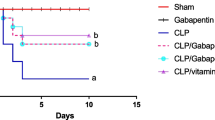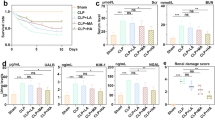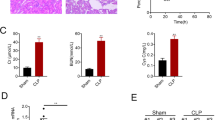Abstract
Acute kidney injury (AKI) is a serious complication of sepsis, which has a high mortality rate. Growth arrest-specific protein 6 (Gas6), the protein product of the growth arrest specific gene 6, has been shown to have an anti-apoptotic effect as well as pro-survival capability. Here, we investigated the effects of Gas6 on sepsis-associated AKI in mice subjected to cecal ligation and puncture (CLP). We found that the administration of rmGas6 significantly reduced serum urea nitrogen and creatinine and improved the survival of septic mice. Furthermore, the renal pathological damage induced by CLP was attenuated by rmGas6 treatment. Finally, rmGas6 reduced the renal tissue apoptotic index and the expression of Bax, while it upregulated the expression of Bcl-2. The data suggest that rmGas6 might be used as a potential therapeutic agent for sepsis-induced AKI.





Similar content being viewed by others
References
Schlichting D, McCollam JS. 2007. Recognizing and managing severe sepsis: a common and deadly threat. South Medical Journal 100:594. doi: 10.1097/SMJ.0b013e31804aa29f.
Bagshaw SM, George C, Bellomo R, et al. 2008. Early acutr kidney injury and sepsis:a multicentre evaluation. Critical Care 12:R47.doi: 10.1186/cc6863.
Rajapakse S, Rodrigo C, Rajapakse A, et al. 2009. Renal replacement therapy in sepsis-induced acute renal failure. Saudi Journal of Kidney Diseases and Transplantation 20:553–559.
Schneider C, King RM, Philipson L. 1988. Genes specifically expressed at growth arrest of mammalian cells. Cell 54:787–93. doi:10.1016/S0092-8674(88)91065-3.
Laurance S, Lemarié CA, Blostein MD. 2012. Growth arrest-specific gene 6 (gas6) and vascular hemostasis. Advances Nutrition 3:196–203. doi: 10.3945/an.111.001826.
Varnum BC, Young C, Elliott G, et al. 1995. Axl receptor tyrosine kinase stimulated by the vitamin K-dependent protein encoded by growth-arrest-specific gene 6. Nature 373:623–6. doi:10.1038/373623a0.
Stitt TN, Conn G, Gore M, Lai C, Bruno J, Radziejewski C, Mattsson K, Fisher J, Gies DR, Jones PF, et al. 1995. The anticoagulation factor protein S and its relative, Gas6, are ligands for the Tyro 3/Axl family of receptor tyrosine kinases. Cell 80:661–70. doi:10.1016/0092-8674(95)90520-0.
Stenhoff J, Dahlbäck B, Hafizi S. 2004. Vitamin K-dependent Gas6 activates ERK kinase and stimulates growth of cardiac fibroblasts. Biochemical and Biophysical Research Communications 319:871–878. doi: 10.1016/j.bbrc.2004.05.070.
O’Donnell K, Harkes IC, Dougherty L, Wicks IP. 1999. Expression of receptor tyrosine kinase Axl and its ligand Gas6 in rheumatoid arthritis: evidence for a novel endothelial cell survival pathway. American Journal Pathology 154:1171–1180. doi:10.1016/S0002-9440(10)65369-2.
Shankar SL, O’Guin K, Kim M, Varnum B, Lemke G, Brosnan CF, Shafit-Zagardo B. 2006. Gas6/Axl signaling activates the phosphatidylserine 3-kinase/Akt1 survival pathway to protect oligodendrocytes from tumor necrosis factor alpha-induced apoptosis. Journal Neuroscience 26:5638–5624.
Hasanbasic I, Cuerguis J, Varnum B, Blostein MD. 2004. Intracellular signaling pathways involved in Gas6-Axl mediated survival of endothelial cells. American Journal Physiology Heart Circulatory Physiology 287:1207–1213.
Llacuna L, Barcena C, Bellido-Martin L, Fernandez L, Stefanovic M, Mari M, Garcia-Ruiz C, Fernandez-Checa JC, Garcia de Frutos P, Morales A. 2010. Growth arrest-specific protein 6 is heptaoprotective against murine Ischemia /rerperfusion injury. Hepatology 52:1371–1379.doi: 10.1002/hep.23833.
Yanagita M, Arai H, Ishii K, Nakano T, et al. 2001. Gas6 regulates mesangial cell proliferation through Axl in experimental glomerulonephritis. American Journal Pathology 158:1423-32. doi:10.1016/S0002-9440(10)64093-X.
Yanagita M, Ishimoto Y, Arai H, Nagai K, et al. 2002. Essential role of Gas6 for glomerular injury in nephrotoxic nephritis. Journal of Clinical Investigation 110:239–46. doi:10.1172/JCI14861.
Batchu SN, Hughson A, Gerloff J, Fowell DJ, Korshunov VA. 2013. Role of Axl in early kidney inflammation and progression of salt-dependent hypertension. Hypertension 62:302–9. doi:10.1161/HYPERTENSIONAHA.113.01382.
Gibot S, Massin F, Cravoisy A, et al. 2007. Growth arrest-specifi c protein 6 plasma concentrations during septic shock. Critical Care 11:R8. doi:10.1186/cc5158.
Borgel D, Clauser S, Bornstain C, et al. 2006. Elevated growth-arrest-specifi c protein 6 plasma levels in patients with severe sepsis. Critical Care Medicine 34:219–222. doi:10.1097/01.CCM.0000195014.56254.8A.
Rittirsch D, Huber-Lang MS, Flierl MA, Ward PA. 2009. Immunodesign of experimental sepsis by cecal ligation and puncture. Nature Protocols 4:31–6. doi:10.1038/nprot.2008.214.
Livak KJ, Schmittgen TD. 2001. Analysis of relative gene expression data using real-time quantitative PCR and the 2(−Delta Delta C(T)) Method. Methods 25:402–408.doi:10.1006/meth.2001.1262.
Doi K, Leelahavanichkul A, Yuen PS, et al. 2009. Animal models of sepsis and sepsis-induced kidney injury. Journal Clinical Investigation 119:2868–2878. doi: 10.1172/JCI39421.
Carl Ekman, Adam Linder, Per Åkesson, Björn Dahlbäck. 2010. Plasma concentrations of Gas6 (growth arrest specific protein 6) and its soluble tyrosine kinase receptor sAxl in sepsis and systemic inflammatory response syndromes. Critical Care 14:R158. doi: 10.1186/cc9233.
Gibot S, Massin F, Cravoisy A, Dupays R, Barraud D, Nace L, Bollaert PE. 2007. Growth arrest-specifi c protein 6 plasma concentrations during septic shock. Critical Care 11:R8. doi:10.1186/cc5158.
Matthew D. Giangola, Weng-Lang Yang, Salil R. Rajayer, et al. 2013. Growth arrest-specific protein 6 (Gas6) attenuates neutrophil migration and acute lung injury in Sepsis. Shock 40:485–91.doi: 10.1097/SHK.0b013e3182a588c1.
Cummings MC, Winterford CM, Walker NI. 1997. Apoptosis. American Journal Surgical Pathology 21:88–101.
Ayşe Koçkara and Mansur Kayataş. 2013. Renal cell apoptosis and new treatment options in sepsis-induced acute kidney injury. Renal Failure 35: 291–294. doi: 10.3109/0886022X.2012.744040.
Yang J, Liu X, Bhalla K, et al. 1997. Prevention of apoptosis by Bcl-2: release of cytochrome c from mitochondria blocked. Science 275:1129–1132. doi:10.1126/science.275.5303.1129.
Wolter KG, Hsu YT, Smith CL, et al. 1997. Movement of Bax from the cytosol to mitochondria during apoptosis. Journal Cell Biology 139:1281–1292. doi: 10.1083/jcb.139.5.1281.
Yin JL, Pilmore HL, Yan YQ, et al. 2002. Expression of growth arrest-specific gene 6 and its receptors in a rat model of chronic renal transplant rejection. Transplantation 73:657–60.
Nagai K, et al. 2013. Dual involvement of growth arrest-specific gene 6 in the early phase of human IgA nephropathy. PLoS One 8:e66759. doi: 10.1371/journal.pone.0066759.
Li Y, Wang X, Bi S, et al. 2015. Inhibition of Mer and Axl receptor tyrosine kinases leads to increased apoptosis and improved chemosensitivity in human neuroblastoma. Biochemical Biophysical Research Communication 457(3):461–6. doi: 10.1016/j.bbrc.2015.01.017.
Hotchkiss RS, Swanson PE, Freeman BD, Tinsley KW, Cobb JP, Matuschak GM. 1999. Apoptotic cell death in patients with sepsis, shock, and multiple organ dysfunction. Critical Care Medicine 27:1230–1251.
Lerolle N, Nochy D, Guérot E, et al. 2010. Histopathology of septic shock induced renal injury: apoptosis and leukocytic infiltration. Intensive Care Medicine 36:471–478. doi: 10.1007/s00134-009-1723-x.
Gareth D. Hyde, Rebecca F. Taylor, Nick Ashton, et al. 2014. Axl tyrosine kinase protects against tubulo-interstitial apoptosis and progression of renal failure in a murine model of chronic kidney disease and hyperphosphataemia. PLOS One 9:e102096. doi:10.1371/journal.pone.0102096.
Acknowledgments
This study was supported, in part, by grants from the National Natural Science Foundation (No. 81401621, 81571937), the Excellent Yong Talents Program of Traditional Chinese Medicine of Zhejiang Province (No. 2013ZQ023), and grants from the Zhejiang Provincial Natural Science Foundation (No. LY13H150004).
Author information
Authors and Affiliations
Corresponding authors
Ethics declarations
Conflict of Interest
The authors declare that they have no competing interests.
Rights and permissions
About this article
Cite this article
Chen, Lw., Chen, W., Hu, Zq. et al. Protective Effects of Growth Arrest-Specific Protein 6 (Gas6) on Sepsis-Induced Acute Kidney Injury. Inflammation 39, 575–582 (2016). https://doi.org/10.1007/s10753-015-0282-2
Published:
Issue Date:
DOI: https://doi.org/10.1007/s10753-015-0282-2




